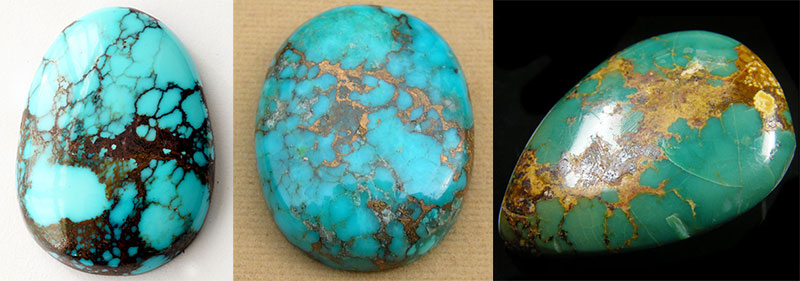Turquoise gemstone
Home ➤ Encyclopedia of gems ➤ Turquoise gemstonePhysical properties of turquoise
| Hardness: | 5-6 out of 10 on the Mohs scale |
| Luster: | waxy |
| Transparency: | opaque |
| Color: | blue, light blue, blue-green, green, often with brown spots |
Characteristics of turquoise
Turquoise (Aztec stone, stone of the East, heavenly stone, calchihuitl, callais) is one of the most extraordinary gemstones.
Turquoise has been known to mankind for a very long time - at least five thousand years, but each nation has its own attitude to this stone, sometimes directly opposite to the meaning of the stone among other peoples.

The name "turquoise" itself comes from the French "turquois", which means "Turkish", since turquoise was previously imported to Europe from the Ottoman Empire. In Iran, which has been the main supplier of turquoise for at least 2000 years, turquoise was called "firuza", which translates as "victory". Although other peoples turquoise was known under other names. For example, the Aztec Indians highly valued turquoise - “calchihuitl”, as they called this gem, and believed that these were petrified tears of the sky goddess (for which sometimes turquoise is called “Aztec stone”). The ancient Romans called turquoise "callais". And the French still call turquoise "Turkish stone."
Varieties of turquoise:
- Blue turquoise (young) - bluish, bluish, sometimes slightly greenish, dense, the most valuable
- Green turquoise (old) - greenish-blue, green, loose, valued lower
- White turquoise - very light, has a slight shade of color, the cheapest
Turquoise has always been a special stone for many peoples and often this precious stone was given some special meaning. For example, in ancient Persia, it was believed that turquoise was the bones of people who died of love. And there they considered turquoise a talisman of love. The Aztecs also considered turquoise a stone of love, but it was also a stone of health and prosperity. But for the Indians of Mexico, turquoise was a symbol of war.
The color of turquoise varies from blue to greenish. Moreover, blue turquoise is considered "young", and green - "old".
In ancient times, turquoise was a very expensive gemstone. It was often used for jewelry, and talismans and sacred animals were also carved from turquoise. In Egypt, images of a scarab, which was a symbol of peace, were cut from turquoise. The Indians carved animal figurines from turquoise, inlaid ritual masks with turquoise. In the East, turquoise was highly valued and talismans and amulets were made from it, and animal figurines were also cut.
Today, turquoise is no longer highly valued, but this gemstone has not become less popular. True, they learned how to fake turquoise a long time ago (among imitations of turquoise, the most famous stone is howlite), which also greatly affected people's attitude to this precious stone.
How much is turquoise
Green turquoise is ranked lower than blue. Beads with natural green turquoise will cost from $60 to $120, bracelets - from $30 to $100. Good quality blue turquoise beads can be priced between $120 and $300. Massive turquoise beads of the best quality can reach $400 in price. Blue turquoise rings are priced between $30 and $100 depending on the quality and size of the stones.
And yet, the most beautiful is considered turquoise, mined in Khorasan (Iran). And the minus of turquoise is that over time the color of turquoise can fade, especially with frequent exposure to soap, alcohol, fatty creams.
| ★ Pietersite gemstone | |
| See also: | ★ Larimar gemstone |
| ★ Tanzanite gemstone |





